Leica SL Review - Page 6 - Interview with lens designer Peter Karbe
Index of Thorsten Overgaard's user review pages on Leica M9, Leica M9-P, Leica M-E, Leica M9 Monochrom, Leica M10, Leica M10-P, Leica M10-D, Leica M10-R, Leica M10 Monohcrom, Leica M11, Leica M 240, Leica M-D 262, Leica M Monochrom 246, Leica SL, Leica SL2, Leica SL2-S, as well as Leica TL2, Leica CL, Leica Q, Leica Q2 and Leica Q2 Monochrom:
Small Camera, Large Print (and large lenses)
By: Thorsten Overgaard. February 23, 2019. Updated October 19, 2023.
Add to Flipboard Magazine.
I had the opportunity to talk with Leica lens designer Peter Karbe some time ago about the direction lens design is taking, and then a talk on the future of Leica cameras with Leica product managers Stefan Daniel and Stephan Schulz.
This is the first part of our conversation where we cover quite a few topics, which perhaps reveals some pointers to the future of Leica photography.
The idea of "small negative, large print"
When Oskar Barnack made the first prototypes of the Leica in 1908, his slogan was 'small negative, large print,' which paved the way for the small Leica rangefinder camera with a 24x36mm film negative. This made photography discreet and portable, and when the first Leica was introduced in 1925, it changed photography forever.
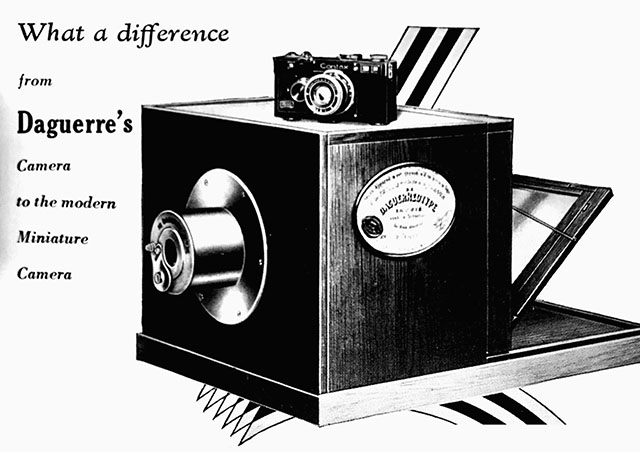
When the first rangefinder camerascame out in 1925, the camera became small and portable. On top of the then traditional cmaera is the Leica
"An important ingredient in the design of the small camera was the high-quality optics that allowed capturing the photograph with clarity and details on the small negative - so it could be enlarged.
As you read this, the world of photography is about to take on a few new directions that seem to stipulate and expand on that very slogan Oskar Barnack had, 'Small negative, large print.
Interview with Leica product managers Stefan Daniel and Stephan Schulz
I had a talk with Stefan Daniel and Stephan Schulz at the LHSA anniversary meeting at Leica Camera in Wetzlar in October 2018 that might provide an idea of the future of Leica M, Leica SL, Leica Q, and the Leica medium format camera.
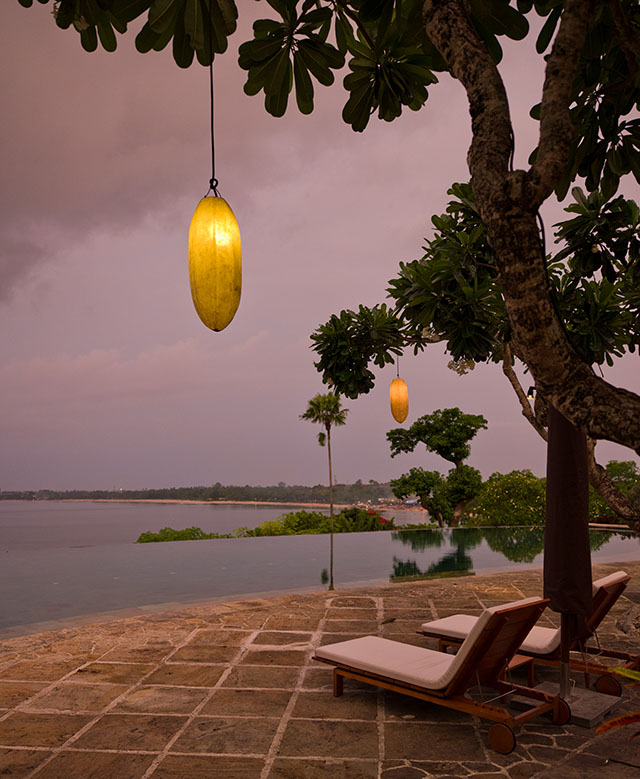
Bali. Leica SL with Leica 24-90mm Vario-Elmarit-L f/2.8. © Thorsten Overgaard.
The future of medium format and full frame
Overgaard: The L-Mount (previously known as SL and T mounts) is now shared with Panasonic, who will make compatible cameras and lenses, and with Sigma, who will make compatible lenses. How is this going to work? Is there a coordinated product strategy?
Stephan Schulz (Product manager for Leica Q, Leica S, and Leica SL): "We are part of an alliance with Sigma and Panasonic, but we are also competitors. This means we are not allowed to exchange any data about target markets, target size, upcoming products, and so on. So, at Leica, we are similarly surprised when Panasonic brings out a new product, like the Panasonic Lumix DC-S1R with 47MP, because we didn't know about it beforehand. This is something we cannot discuss with our partners."
Overgaard: The Leica SL concept with a 'large enough lens bayonet for any design' and the idea of a professional mirrorless camera seems to have prompted Nikon and others. Even though it's a camera concept with much bigger camera bodies and lenses at a time when everybody seemed to agree that 'full-frame is the new medium format,' and why smaller mirrorless cameras are the future, and then it will eventually be smartphones.
Stephan Schulz: "Our L-mount is 51.6 millimeters, and that is big enough for any lens type we could wish to design. This was checked by Peter Karbe and his team many, many years ago. It's big enough for full-frame, and this L-mount was first and foremost made for full-frame.
"The Nikon Z-mount is a larger mount (55mm). This may have even more, let's say, possibilities to make optical design more challenging, but on the other hand, we think the drawback is you cannot make really small cameras.
"Our L-mount was designed in a way that it's big enough for everything, yet as compact as possible. We can make nice compact cameras like the Leica CL, for example. If you tried that with the Z-mount, it would not work because the mount is too large."
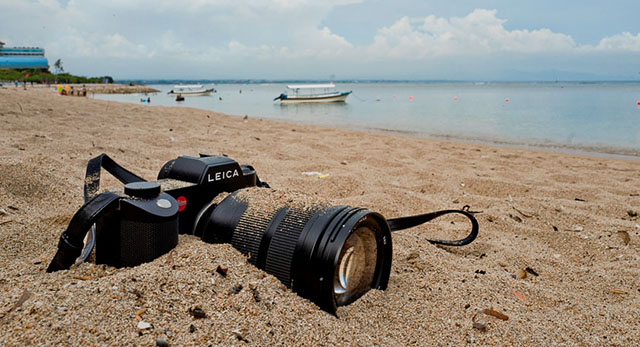
Leica SL at the beach, with the 24-90mm zoom. © Thorsten Overgaard.
Stefan Daniel (Vice President Photo, Sport Optics & Technology): "The L-mount, formerly known as the T-mount when we launched it with the Leica T in 2014, actually dates back to the year 2010 or 2011 when Peter Karbe and his colleagues designed it.
"Initially, we had the plan to use the M-mount to go full-frame mirrorless, but it proved not to work out because the back focal length is too large, and the diameter is too small. So we came to the conclusion that we needed a new mount.
"So, the thoughts for the L-mount have proven to be spot on, thanks to Peter Karbe!"
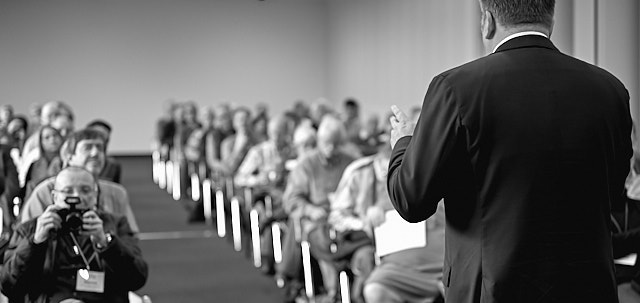
Stefan Daniel speaking at the LHSA 50th Anniversary in Wetzlar. © Thorsten Overgaard.
Overgaard: The full frame is becoming "the new medium format". The Leica S is the medium format currently, but it seems to slide over to Leica SL?
Stephan Schulz: "In total, there are ten focal lengths in the Leica S system, some with Central Shutter (making it sixteen model variants in total).
For Leica S, there have been several reasons it is not mirrorless. If you use a medium format camera, we presume that you really care about image quality, and from our point of view, mirrorless medium formats that were available up to 2020 when we released the Leica S3, produced a lot of heat. Heat means that the noise goes up. Increased noise means image quality goes down.
With the 64-megapixel Leica S3 (2020), we have managed to achieve more dynamic range than the previous models, higher sensitivity than the previous models, better colors, and even lower noise. Also, the pixels are smaller, allowing for more microdetails.
Leica S is not designed for mirrorless live view; it's designed for DSLR. We believe it's a very good alternative to the mainstream. Maybe one day we will have to change it to mirrorless.
For the moment, we don't plan to add additional lenses to the Leica S lineup. The really long focal lengths are missing in the S system because the longest is 180mm. But we think that, in regards to longer focal lengths, it's not only about resolution; it's also about stabilizing the image. There are a lot of things that need to be done to make good images with long focal lengths. We believe the Leica SL system is more appropriate for such applications."
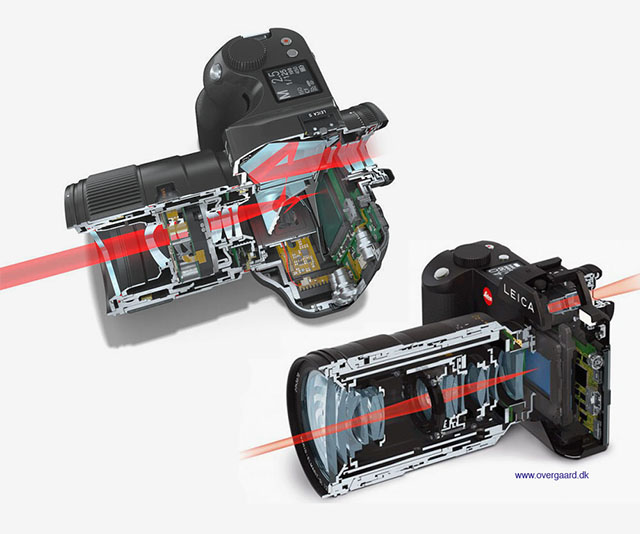
Mirrorless vs reflex dSLR: The Leica S3 on top is a medium-format DSLR camera where the image is reflected 90 degrees up into a prism and can then be seen through the viewfinder (the photographer sees through the lens). The Leica SL on the bottom is a 'hybrid mirrorless' camera that does not have a mirror: The image is read directly by the sensor and displayed on a small screen inside the viewfinder (the camera sees through the lens). © Thorsten Overgaard
Overgaard: Image Stabilization is something people ask about, both in the lens and in the camera. It takes up space in the lens and/or in the camera. Is there a solution in the future for that?
Stephan Schulz: "For in-body image stabilization, it's really a question of body size. We have a priority on the body size, which has a great heritage, particularly for the Leica M, and having image stabilization needs some space in the body to move the sensor.
"We cannot talk about future products in our strategy, but you can be sure that we have a close look at in-body image stabilization. We think if it's helpful for our customers, we will do it."
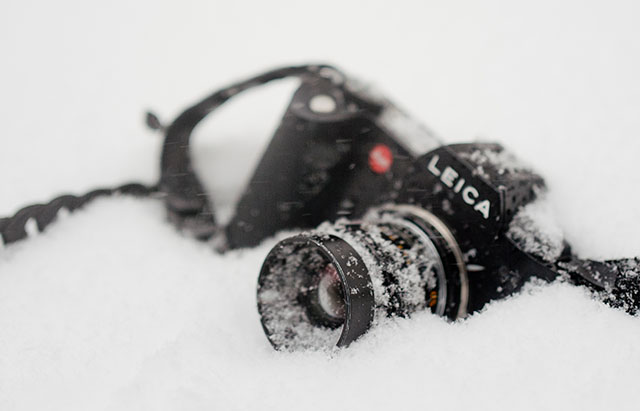
Leica SL in the snow. © Thorsten Overgaard.
"I would say that with in-body image stabilization, you have a benefit when using non-stabilized lenses, which can benefit from it. When you put a Leica M-lens on a Leica SL, you then have a nice image stabilization.
"By combining in-body image stabilization and in-lens image stabilization (in the L-lenses), you can correct different frequencies of shake, which is also a benefit. Ultimately, this will result in gaining more f-stops so you can photograph at lower shutter speeds without shake."
Stefan Daniel: "Yes, one more thing to consider when we think about prime lenses; when you develop them to very high performance, like the new APO-Summicron line, it's much easier to make a high-performance lens in a compact way if the image stabilization is in-camera. The APO lenses are compact lenses at a very high level, without optical image stabilization."
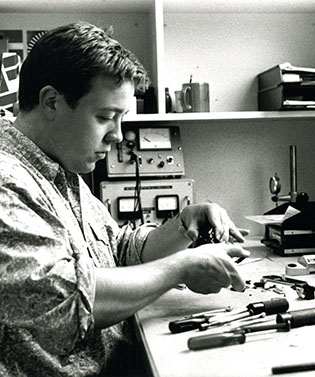 |
|
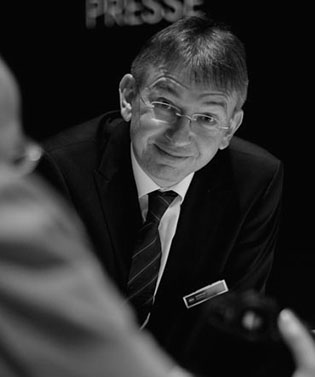 |
| Stefan Daniel is the Global Product Director. He has been working at Leica Camera AG since he was around 17 years old (as shown in the picture above). Starting in customer service repair, he has worked through various technical and administrative departments, rising within the organization of Leica Camera AG to become essentially the second-in-command next to the CEO. |
|
Stephan Schulz was the one responsible for the development of the Leica S, which was such a crucial project for Leica that his marching orders from Dr. Andreas Kaufmann (the majority-owner of Leica) were simply, 'You better make sure it is a success, because (we're screwed if it doesn't work), we've invested everything in this project.'
He did come through with the Leica S, which was sort of the Apollo 11 project of Leica, creating a lot of new technology that has been used in Leica M, Leica SL, Leica Q and other camera models ever since. Today he is responsible for Leica SL and Leica Q. |
| |
|
|
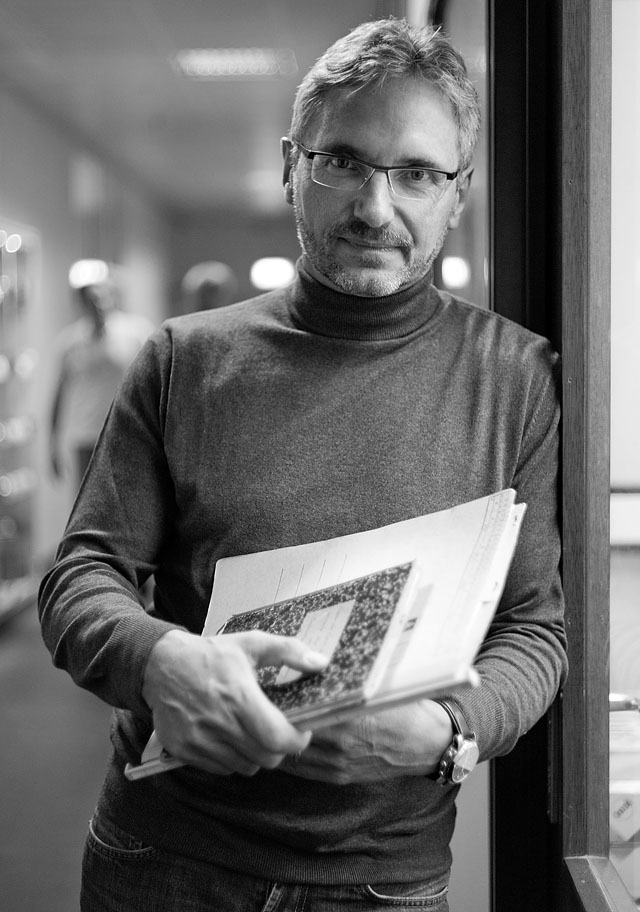
Peter Karbe follows in an impressive line of legendary optical designers at Leica, from Max Berek to Dr. Mandler. He has been the chief optical designer at Leica Camera AG in Wetzlar, Germany since 2002. He retired in 2023 but then decided to stay. He counts as the only living rock star of Leica. © Thorsten Overgaard.
Peter Karbe Interview: The Era of Big Lenses
Overgaard: Now we have the SL-lenses, TL-lenses, the S-lenses. All the lenses get bigger, compared to the traditional Leica M lenses.
And now I see Nikon, Canon and Fuji also just open it up and make big lenses so they have lots of space to work with for their optical designs. The focus of lens design seems to be to enable the optical designers to control everything to perfection?
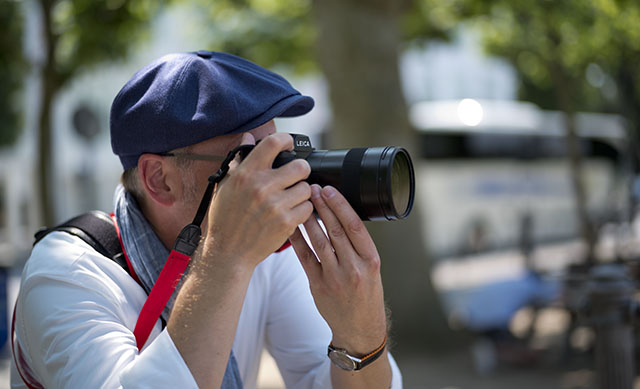
Rob Cale with his Leica SL and 50mm Summilux-L f/1.4 in Frankfurt. © Thorsten Overgaard.
Karbe: “I think Nikon said that they really followed our concept, completely, 100%, in their new Nikon Z.”
Overgaard: Yes, Nikon seem to want to be Leica. They’re even making a 58mm Nikkor Noct f/0.95 and also follow the concept of offering adapters so one can use all previous and old Nikon lenses. Just like you did with the Leica SL four years ago, in 2015.
It’s a bit like, do you remember in the old days with photography, we had the 35mm film format. Then they introduced the APS film system because everybody would buy new cameras, and then you could raise the price of developing film and making prints. I feel it's almost the same thing happening now. The dSLR is down-trending and all agree it will die and mirrorless takes over. But now with the Leica SL, people are going to buy lenses and larger cameras again. We start a whole new era, making money and new glasses. I kind of dig all that, it’s a revival of photography. But then again, from my viewpoint, the ideal is to make it like the Leica M systems where all the lenses are as small and compact as possible. When you use your excellence to fit great optics into those small lenses, it tends to produce special fingerprints of lenses.
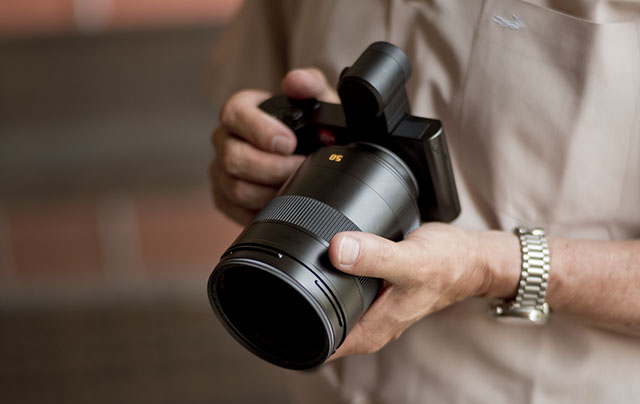
Leica 50mm Summilux-L f/1.4 on the Leica TL2. © Thorsten Overgaard.
Now you get to go in a different direction. You predicted, scaled and designed the SL lens system to allow all the space you need to make perfect optics. It’s very forward thinking and the ideal solution. But I’m a bit like, ‘Yeah, that’s nice, but I'm not gonna carry that stuff around in the city or in the rural setting, and so I want the compact excellence.’
Karbe: “What is it that you want? Compact or best performance? Or both?”
Overgaard: Look at the Leica M lenses. You have the best lenses in the world, and they're compact. I like a camera system I can always wear.
Karbe (seeing where this is going): “That's an ideal advantage.”
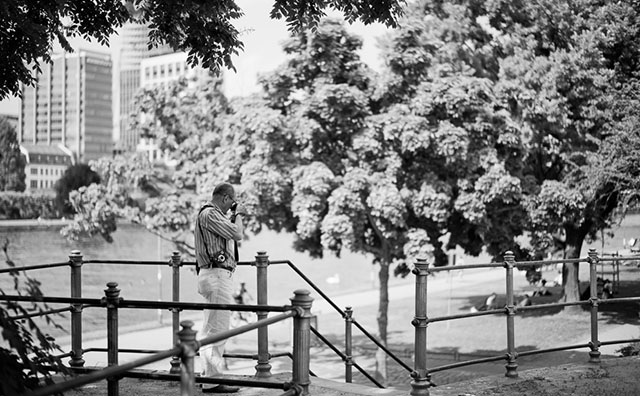
Out and about with the compact Leica M system. © Thorsten Overgaard.
Overgaard: The 50 APO is extremely compact, and it's perfect. One of the points you made with that lens was to make it extremely small and compact, yet so utterly precise. Sort of the opposite of making large SL lenses, because the 50 APO required such precise engineering and assembly that it’s no joke.
As a side-remark, I have this LHSA limited edition 50 APO in solid brass. It's the same compact APO design, but it's bigger than the 50mm rigid. So I looked at this thing, and I wondered, ‘Did Peter Karbe cheat?’ Does he just give himself more space to mount lenses?’ In theory, it should be smaller than the rigid, but it isn't. Do you just take all the space you can for your lenses, or what?
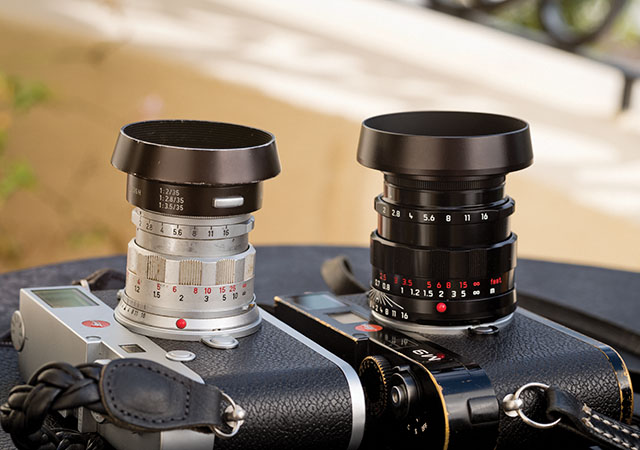
The 1956-model of the 50mm summiron-M f/2.0 "Rigid" and the limited edition black laquer 50mm SPO-Summicron-M f/2.0. © Thorsten Overgaard.
Karbe: “Ha ha! No, the LHSA edition is the special editions defined by the customer who ordered. In this case that certain style, the classic lens barrel design, had a larger size than the original 50mm APO.
“We try to turn the lenses into the most compact and best performance lenses. On the other hand, we want to enlarge our fast lens portfolio for the 75 APO-Summicron-SL f/2.0 and so on.
“In principle, look at the Leitz Cine lenses; APS system sensor size but five times bigger lenses than all that.
“It's bigger, and the bigger it is, the more performance you can implement. And I think the customer expects performance.
“Let's go a different way: Which performance is needed in the future? Do you need 60 megapixels? I don't think so. But probably we’ll get it anyways, yes.
“So, when the lenses perform better, you can concentrate on the decisive moment. The rest you can do later. Take a little bit more space, so you only have to touch the button at the right time. If there are some adjustments, you can do them later. You capture a large picture at the right moment.
“You expect from yourself to take the whole and final picture, ready to show it. But it is better if you have more space, and you can – let's say like the Leica Q (Model 116 with 24 megapixels), you have your frame selector so you can choose 28mm, 35mm or 50mm. If you have the best lenses, then you can crop. This is kind of medium format behavior, because in the past you had 6x6, and then you had the mask inside. You have your full medium format negative, and then you say, ‘Okay, I want to have this part only’.
“Then when we improve the resolution of the camera – the megapixels – and we have the best performance within the lens – the optical performance and resolution of details – you are more flexible. Because zooming takes time.
“And you can only have one shoot. But if you have an overview, you can take a picture of that overview and then crop later.
“That’s what I think is part of the future. And the Leica Q is well accepted, and we apply this.”
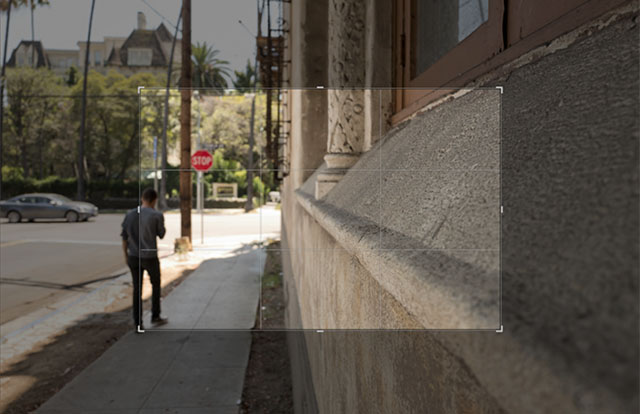
Leica Q has an 28mm lens but you can crop as here to see only 50mm. © Thorsten Overgaard.
Cropping in camera
Overgaard: Yes, People haven't taken the Leica Q concept on completely, but they should. With the Leica Q, I totally see the idea that you don’t need a 24-megapixel frame. You crop the image to 50mm and you have an 8-megapixels image that is actually fine. The idea is brilliant, but I also hear and see that people feel they should get all the 24 megapixels. They feel they are missing out, instead of looking at the 50mm picture in 8 megapixels and seeing that it actually works. People still want a 50mm Leica Q and a 35mm Leica Q that uses the full frame, but that’s not the way you are going.
Laptops get smaller, smartphones get smaller. The screen gets bigger, but the electronics get smaller and smaller. So while all technology gets smaller, why is it that the lenses get bigger? The camera gets smaller, but the lenses get bigger?
I see a point in the Leitz Cine lenses, the Leica S lenses and the Leica SL lenses, that the barrel is of similar size within each concept. I know that is also a consideration for production and readiness of parts and machines. And the Leitz Cine lenses won a technical Oscar for that, so I respect it.
But small is beautiful, isn’t it?
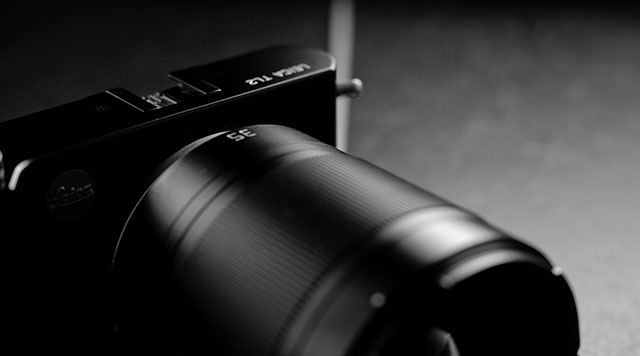
Leica TL2 with Leia 35mm Summilux f/1.4. © Thorsten Overgaard.
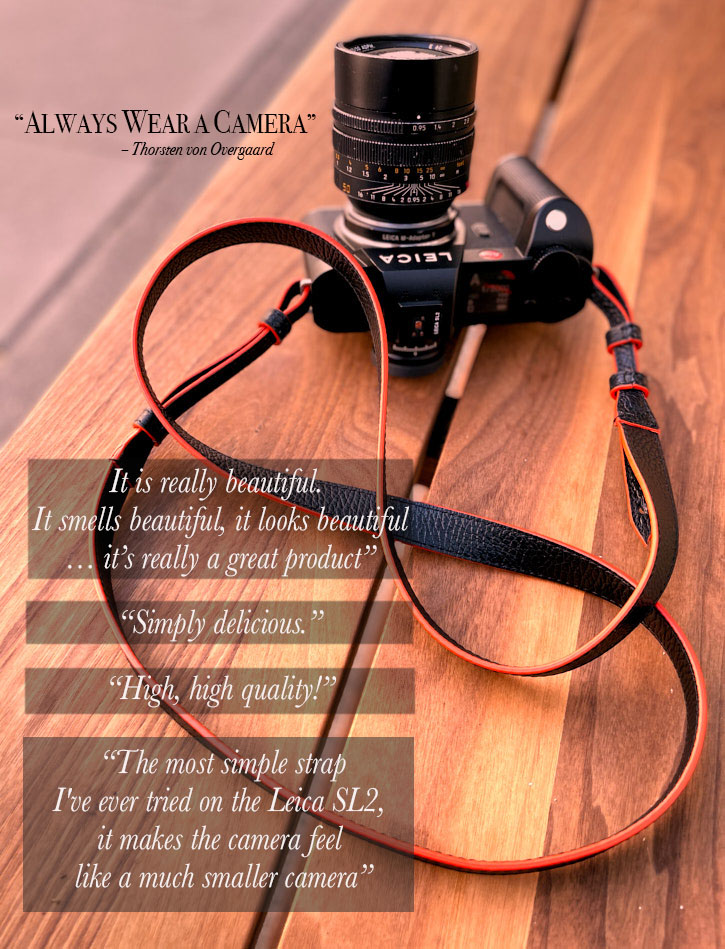
The "Magnum" strap for the Leica SL comes in two lengths, 125cm and 145cm.
Karbe: “The same size lens barrels, that is a platform concept. To have stable correction and new technologies, we implemented scalable processes in the production and all those things that we implemented.
“But the main reason for the bigger size for the SL system is to implement our autofocus technology, to have it very fast and high performance. Some other systems have different autofocus systems, they are very slow, and their performance is not that good. We have designed the focusing inside and then we can control the performance quite well from infinity to close focus.
“The lenses has auto focus that is able to move very fast, and as we move on, the cameras will be able to move the parts faster.
“The new lenses will be ...ha ha … the MTF is out the roof, there's no space for more. And so, this is the reason why we need it to be bigger, because the electronics required new optical concepts with larger focus groups. Large focus groups in combination with high performance; we want to find new solutions. That's the reason why we are going bigger.
“With the M system, we still target to get the best performance in small size. But as I have said before, the 75mm Noctilux with f-stop f/1.25 is the widest a Leica M lens can be. 60mm in diameter, that is the maximum due to the rangefinder view”.
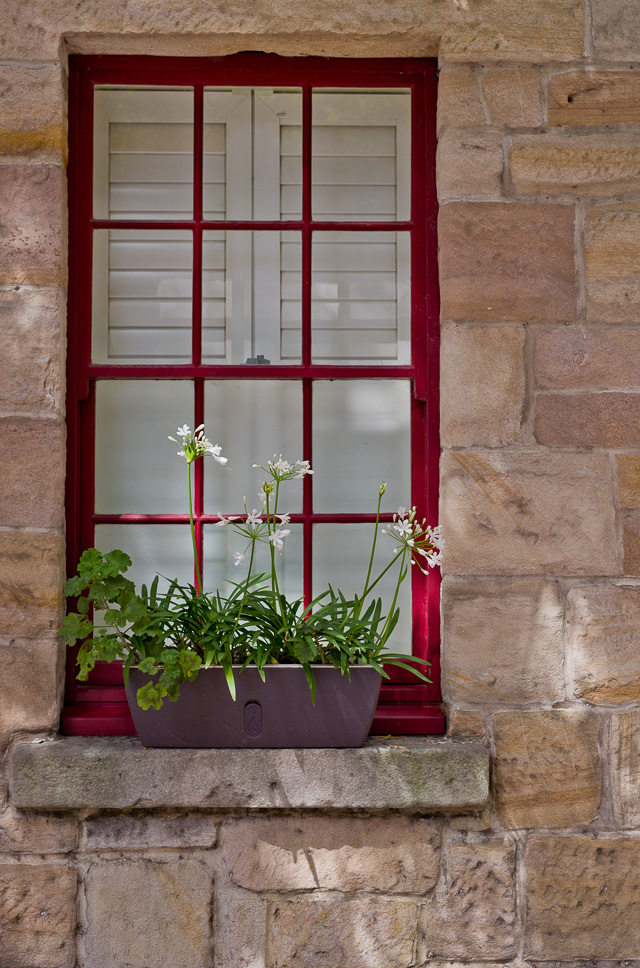
Leica SL 601 with Leica 50mm APO-Summicron-M ASPH f/2.0. © Thorsten Overgaard.
Overgaard: Yes, you can't really make a 35mm or 50mm smaller. It's like physics, you know. So you say, with future cameras, we're going to get more megapixels, that’s always a given even Leica Camera AG has been nice and kept it to 24 megapixels across the line for a while now.
But you just started scaling the lenses for so many megapixels, and the resulting resolution and quality of the lenses is so high that you can basically crop it.
Karbe: “I think all lenses are prepared for the resolution. We don't need to make them bigger. We got rid of the worry of such things, the higher resolution and all. The new lenses are prepared to work with higher resolution.”
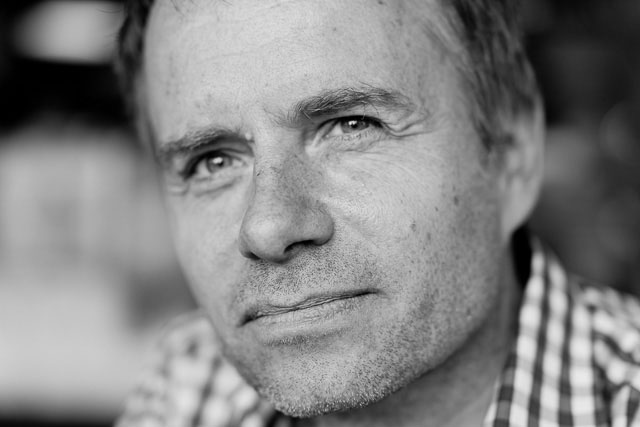
Leica TL2 with Leica 50mm Summilux-SL S ASPH f/1.4. © Thorsten Overgaard.
Overgaard: Yeah. I can see that. You have the Leica M, the Leica MP, and they’re beautiful cameras. The miracle is that the mechanical perfection aligns. But now the Leica cameras and lenses are less handmade and require less adjustment.
The Leica M; you have to send it in for adjustment from time to time, whereas with a Leica Q or Leica SL there is no need for adjustment. You buy it and you use it. That makes life so much easier for Leica and everybody. This is a new era.
If you take some of the old Leica lenses, then you get some ‘rock and roll’ again because they’re out of control. Dr. Mandler’s ideal was probably also perfection when he made the first Noctilux f/1.2 and the 75mm Summilux f/1.4 and so on, but it was perfection with that current technology. What you could see in the image back then was what you could see, and now you can see more, because you can zoom in more.
Karbe: “Yes, yes, yes, and go closer.”
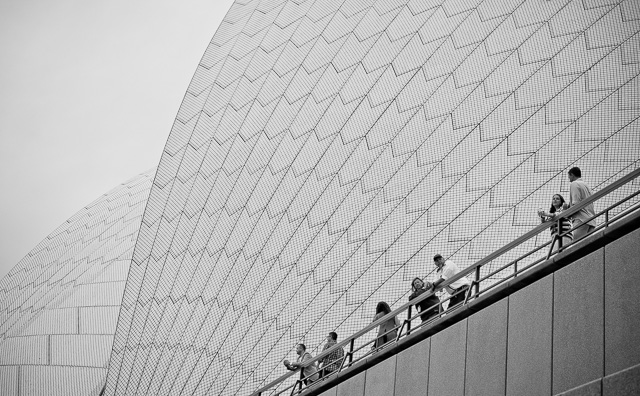
Sydney Opera House. Leica SL with Leica 24-90 Vario-Elmarit-L f/2.8. © Thorsten Overgaard.
The 100+ megapixel camera
Overgaard: So, I have an interesting questions here: If you look at the Leica SL lens or the Leica TL lenses, how high up can you go in megapixels before you must say ’Okay, now we have to improve the lens design again’ … Have you made any predictions for that?
Karbe: “Yes of course. For the Leica SL, it’s 100 megapixels.
Overgaard: 100 megapixels?
Karbe: “Yeah. No problem.”
Overgaard: (Here I shifted my pen from my right hand to my left hand and scratched my ear. I looked over at Peter Karbe and noted a triumphant expression in his face): No problem?
Karbe: “Yeah, no problem.
“Of course, if you are doing pixel peeping and such … It’s like looking at the thickness of the paint. But, Look at the picture.”
| |
|
|
|
|
|
|
| |
Buy the new eBook
"Composition in Photography"
by Thorsten von Overgaard |
|
| |
|
|
|
|
|
|
| |
Composition in Photography
- The Photographer as Storyteller
This book will inspire your photographic eye and make you wonder about all the possibilities you can now see.
In this exciting new book Thorsten Overgaard expands and simplifies the subject of composition. It's elevated from geometric patterns to actual storytelling by practical use of space, rhythm, time, colors, emotions and intuition in your photography.
- The Basics of Composition.
-
Composition in the Third Dimension.
- Picture Stories.
- Accenturating with Light.
- Photograph as a Melody.
- Which lens are you?
- Fear of sharpness?.
- Vanishing Point.
- The most important
element of composition
- What is the unknown secret
why it is you mostly can't get
the Rule of Thirds to work?
- How does a camera see
differently than the eye?
- What does quantum physics and
photography have in common?
- What's the greatest adventure you can
set out on in photography these days?
- A Sense of Geometry.
Only $398.00.
Order now. Instant delivery.
864 pages. 550 Illustrations. |
|
"It’s your best work so far"
"I’m being gently led"
" I love this book!!!"
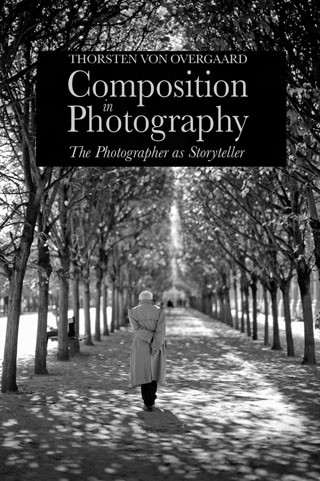
"The book is incredible"'
"It’s like therapy for the human spirit."
"Beautiful and inspiring"
"Full of practical advice
and shared experience"
'I love how hands-on and
laid back Thorsten's witting style is"
"Inspiring"
"Intense and thought-provoking" |
|
| |
 |
 |
|
100% satisfaction of money back. |
|
| |
|
|
|
|
|
|
Overgaard: That's very interesting, because 18 megapixels for a still is sort of enough, that is what the eye can resolve. In video it’s 4K. But of course we are getting 8K video cameras and lenses, and we’ll get 50 megapixels and 100 megapixel cameras, and it's just going to keep going on. I think it's a slower rate now, thankfully.
Karbe: “I think with the SL primes, the 90mm and 75mm and the rest, performance-wise, we are on the level of the Leitz Cine lenses. It's very close, but the size of the SL lenses is much smaller. So I think the SL lenses symbolize a new performance benchmark.”
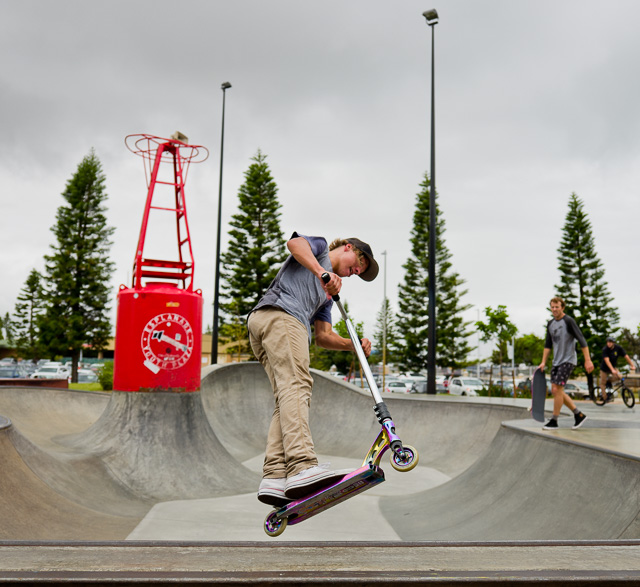
Leica SL with Leica 24-90mm Vario-Elmarit f/2.8. © Thorsten Overgaard.
| |
|
|
|
|
| |
New eBook from Thorsten Overgaard:
"The Portrait Book
– How to Make People Look Beautiful" |
|
| |
|
|
|
|
| |
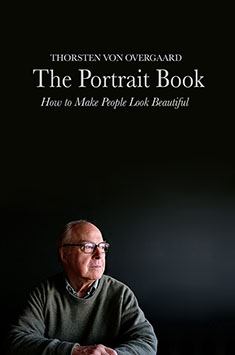
"Love the book.
Very insightful and very well done"
"You are my favorite author" |
|
Questions answered in this new eBook:
- What’s the secret behind Mona Lisa?
- How do you make anybody look beautiful?
- What is the right timing for portraits?
- What do you say to the people?
- How to photograph your spouse?
- How to edit portraits?
- What is the one right thing in all portraits?
- How to do research for portraits?
- What is the secret to light in portraits?
- Which lens to use for portraits?
- What is the composition rules for portraits?
- How to photograph children?
- Who should I photograph?
- How to do street portraits?
- and more...
Buy Now. Instant Delivery.
Only $298.00
578 pages.
Released April 5, 2020
|
|
| |
#1905-0119 |
|
100% satisfaction or money back. |
|
| |
|
|
|
|
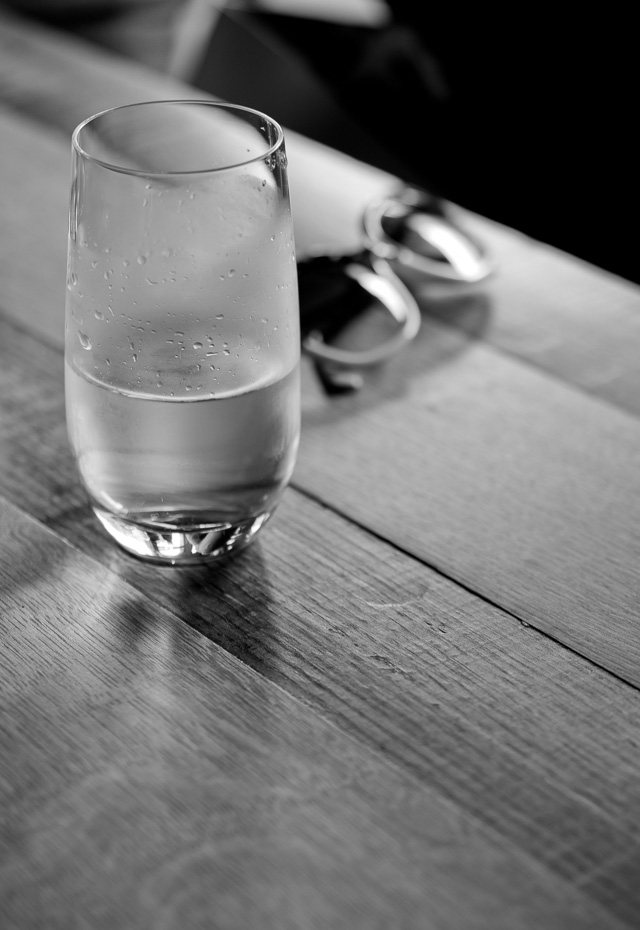
Leica SL with Leica 24-90mm Vario-Elmarit f/2.8. © Thorsten Overgaard.
One lens and a 250 megapixel camera
Overgaard: If we imagine 100-megapixel or 250-megapixel full-frame sensors, and a lens that can resolve definition enough, then we could basically do with just one lens, and crop thereafter.
I asked you a year or two ago, what is the focal length of a pinhole camera lens, and you said, “It depends on the distance". Basically, you move the lens and you get a wider picture, but the rest remains.
In my Composition book, there is this photo where I went out in the park: I took a 75mm photo, and I took a 28mm photo, and I put the 75mm on top of the 28mm photo, and it all matches. It’s all the same.
What I am getting at is, I can shoot everything with a 28mm and crop it later. Like with the Leica Q, one 28mm f/1.7 lens and I crop digitally in the camera or later. I crop it to 90mm, and it’s a 90mm f/1.7 photo
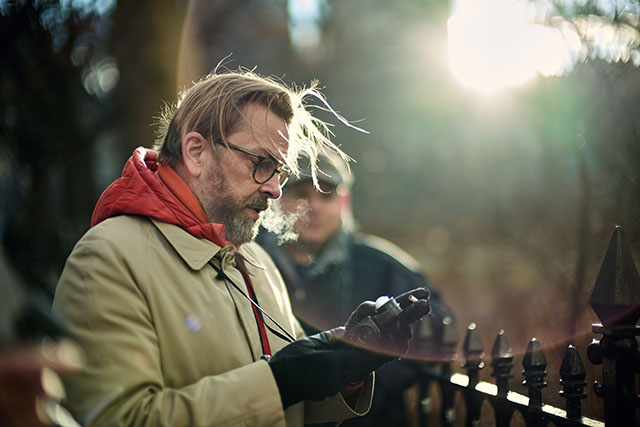
Thorsten Overgaard in New York. Leica SL with Leica 50mm Noctilux-M ASPH f/0.95. © Dave Chenn.
Karbe: “Yes and no. What's is the difference is the depth of field. It won’t be 90mm f/1.4.
“The perspective will be the same, but the depth of focus will be different. It’s hard to see in your example.
“If the depth of focus is big enough, you will not see the difference. Because the entrance pupil of 28mm is smaller than 90mm. The equivalent F-number is the number multiplied with the crop factor. You have 28mm f/1.4, so 75mm will be f/4.0.”
Overgaard: I can't see it in this picture…
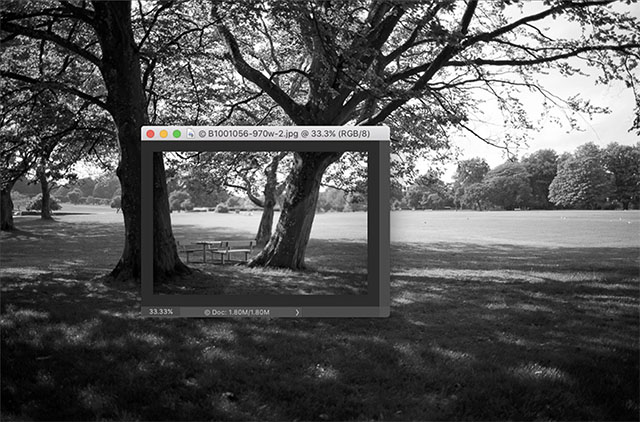
75mm photo laid onto a 28mm photo. © Thorsten Overgaard.
Karbe:”Take a look and see it again.”
Overgaard: Hang on! This kind of destroys the idea that you should have lots of lenses because it just ... you have one lens and then you can do anything. But today, you put a 75mm on the camera to be able to think 75mm and you feel like you dragged the background closer, and as far as I can tell … well, why not just use one lens and it does it all? It takes the sexiness out of photography to only have one lens for all, but in the Leica Q it’s quite elegant because you actually see 50mm in the viewfinder. So even though you use a 28mm f/1.7, you get to see what a 50mm lens does. But then you say the f-stop changes.
Karbe: “Before I started my career as engineer, I started my apprenticeship as photographer. And we had to take pictures from one point of view with different focal lengths.
‘You take the widest lens and crop it, and make a comparison with the long focal lens. Then you see it's the same. There's no difference, this is what you learn, it's basics. But what will change is the depth of focus."
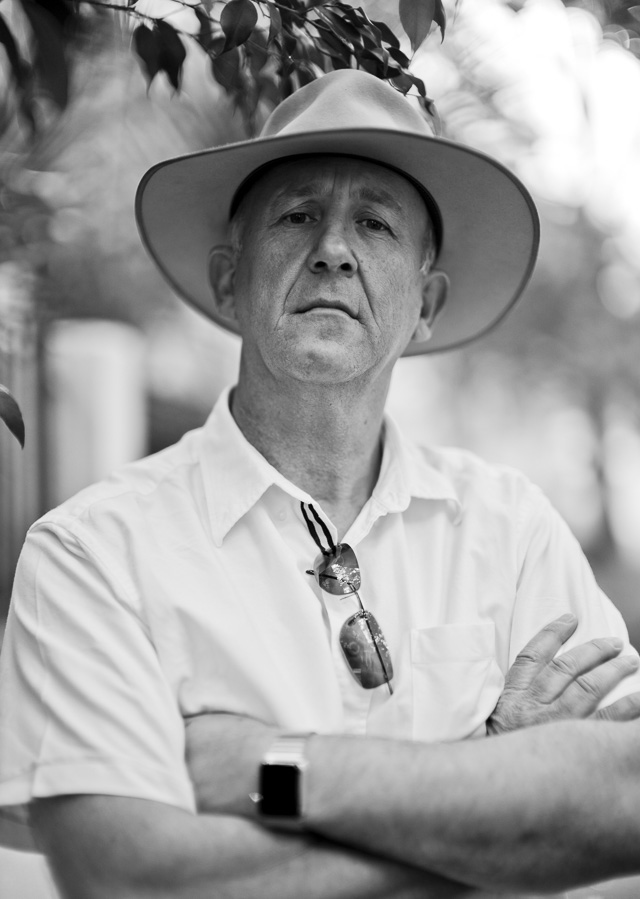
Leica SL with Leica 50mm Noctilux-M ASPH f/0.95. © Thorsten Overgaard.
The 35mm Noctilux
Overgaard: It's always a question, what's next? I think everybody wants the 35mm Noctilux. I don't know why?
Karbe: “Of course there are white spots on the portfolio, I think. Especially for the fastest lenses, the f/1.4.
“I would like to start a story of APO-Summicron lenses. The first was the 90 mm APO-Summicron-M ASPH, you know. The second was 75 APO-Summicron, then the 50 APO-Summicron.
“Now I had to look at the 90mm APO-Summicron for the Leica SL, and then the 75mm APO-Summicron.
"I think that after the APO's – as the single name, or it should be the single name – there's no need for more. (Peter Karbe laughs).
“Just with the SL system we need APO-Summicron in the lineup so we can make a story out of it. With this lens system you can grow a lot, and then you can crop a lot, and you can concentrate on the specific decisive moment.”
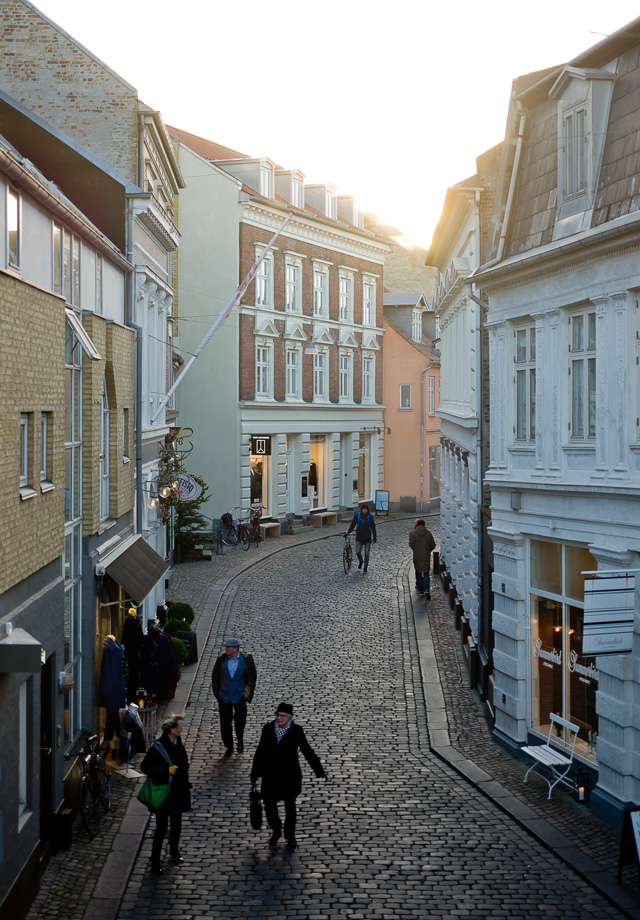
Leica SL with Leica 50mm Summarit-M f/2.4. © Thorsten Overgaard.
Wide-angle APO lenses
Overgaard: Would it make a difference if you made a 35mm or a 28mm APO design? Or like, let’s say you have the 28mm f/2.0, which is a fairly new design. If you added APO to that one, in the M system?
Karbe: “It's close by, yes, but we are not so familiar with doing this with wide angle lenses. We perhaps have to think through the principle. But at the moment I'm looking at the SL system, because of the imbalance. Highest performance of that system.”
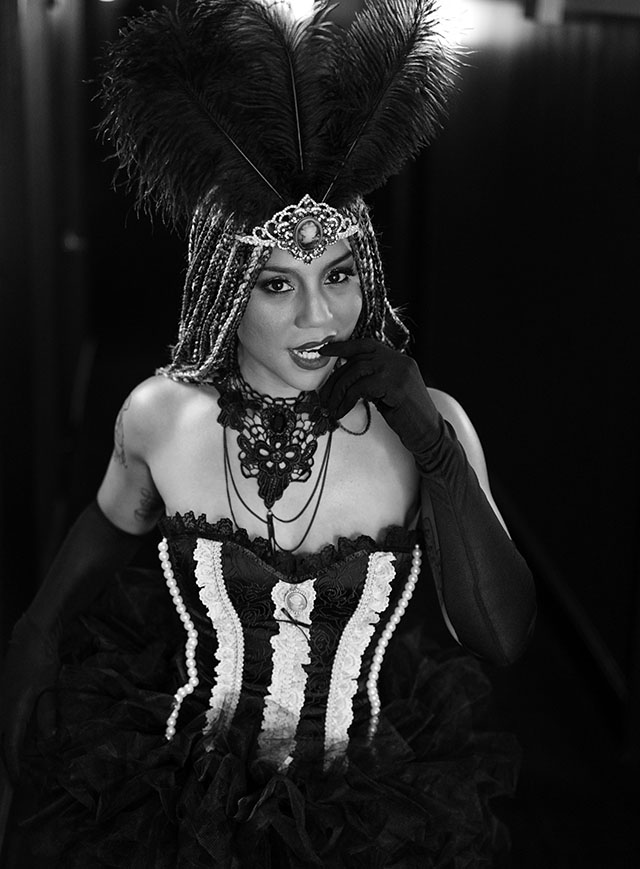
ACE Hotel in New York. Leica SL with Leica 50mm APO-Summicron-M f/2.0. © Thorsten Overgaard.
Overgaard: Do you use the Leica SL a lot yourself?
Karbe: ‘Yes, I try to find out how to ... How I can perform better with this. Nobody needs 2.5-meter tall prints. Let's think it differently. Let's say there is a football stadium, and you have an overview, and you can take a picture of it. You can have one shot and four pictures. You can tell a story like that.
“This is accelerated of course. This is the wish of everybody. Take pictures and the rest is done in the software.
“Could be the future, yeah.”
Overgaard: There was a period where ‘everybody’ thought doing video in a photo studio of a model was the way to go, and then just pick the frames from it you wanted. It didn't really work that well, it was just for a while. There's a lot of work in picking the frame because now you have to look through 4000 pictures instead of 40.
Karbe: “My thinking is that the SL system is just more for the photographer. An assistant for the photographer. The Leica M camera is a teacher.
“The Barnack concept from the beginning of the Leica was the moment, or snap shots. I was just thinking of Barnack. It's a decisive moment.”
Overgaard: Barnack also said, ‘Small negative, large print’. We’re getting to a new era of that philosophy in our day and age. There's probably more than two ways of perfection. One thing is that you make it a perfect picture in the camera; that's one type of perfection. The image quality is the next step in getting closer to perfection. The Leica M, in my view, combines both.
Karbe: “You can take the older lenses or you can take the new ones. With the new ones you can take pictures and do more with them. That's the difference. You can challenge yourself.’
Wandering spirits from the past
Here we took a break.
This was quite a bit for me to process. Peter Karbe works on the future lenses, in particular filling up the map of Leica SL lenses (the “L-Mount” as they now call them).
I like small lenses, and I like those old lenses that Peter Karbe seem to regard as some wandering spirits from the past.
We took a short break to refill our coffee mugs, and by the time I had added sugar and milk, I had through it through and was ready to backfire.
To be continued ...
Keep an eye out for the second part of the interview, “The 75mm Noctilux and ‘Rock and Roll’ lenses”.

Was ist das?
What are the different Leica SL buttons and symbols for?

Bayonet lock and red dot
There is a bayonet un-lock button on the Leica SL that is pressed to release the lens or adapter.
If an adapter is attached, that too has a silver button that is pressed to release the lens from the adapter.
The Leica lenses all have a red dot on them. It has to be positioned so that it "meets" the silver button on the camera or adaptor, then turn the lens clockwise till it locks.
When using one or two adaptors on the camera you will likely press the wrong button a few times but then you will get the hang of it. |
|
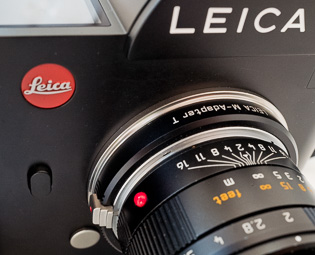 |
| |
|
|
ROM contacts on the lenses
The metal contacts inside the bayonet of the Leica SL and Leica T lenses and the adapters are for communication with the camera. For Leica T and Leica SL lenses they power the aperture and the autofocus motor inside the lens from the camera battery, and in the case of T and SL lenses they tell the camera the focus distance and zoom position as well. In all lens combinations they supply the camera with info about which lens is used.
For Leica M lenses there is no AF and there is no info about the aperture going to the camera. For Leica R lenses it is (un-)likely that the R lenses with ROM contacts will give info to the Leica SL about which lens is attached. We will know when that adapter is available in 2016. |
|
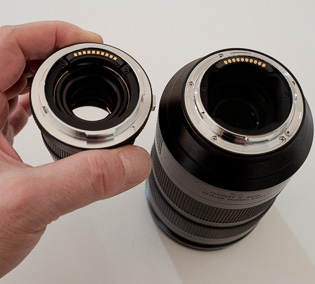 |
| |
|
|
ROM contacts in the Leica SL
Inside the bayonet of the Leica SL is the contacts to communicate with the lens' or adapter's contacts.
And yes, that is the sensor you see below and behind it. It is unprotected like this, though it has a glass surface.
When you release the shutter, a shutter curtain will go over the sensor and back in hiding again; after it has cleaned the sensor for digital signals and made the sensor ready to record the next picture. |
|
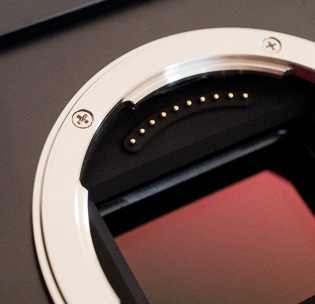 |
| |
|
|
The strap lug
The strap lug on the Leica SL has a square shape and doesn't take metal rings as the Leica M and other cameras. It has to be a nylon strap or leather strap that goes around it. |
|
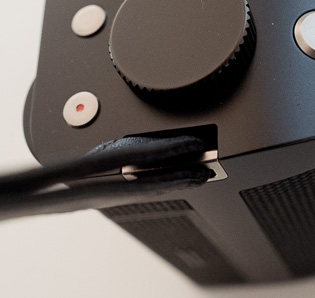 |
| |
|
|
The diopter adjustment
You can turn the diopter on the viewfinder to adjust to your eyesight.
The GPS unit
To the left of the top of the camera is the plastic roof that seals the GPS unit. It needs a plastic roof to be able to communicate with the satellites.
Stereo microphone
The two sets of four small holes on top of the camera are the stereo microphones for video. |
|
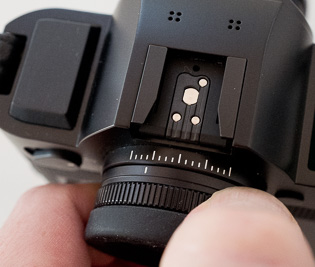 |
| |
|
|
The rubber thing in the bottom
The soft rubber field under the camera is not GPS or WiFi. The rubber seals the contacts that are used when the battery handgrip is attached. |
|
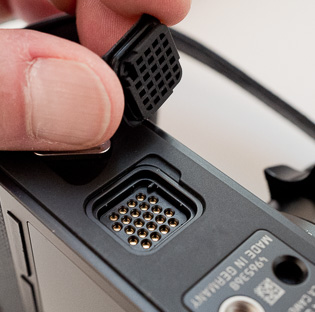 |
| |
|
|
The rubber thing on the side
This is not a handgrip but a rubber cover of the contacts for HDMI, remote control, USB3 and external sound recorder. |
|
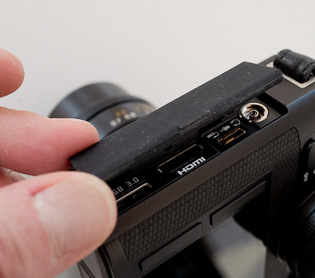 |
| |
|
|
The scan code and two holes
The screw mount hole in the bottom of the Leica SL 601 is for attaching it to a tripod, and the other hole is for keeping the camera firmly in place on the tripod so it doesn't rotate.
This plate also contains the serial number as well as a scan bar that can't be read by the iPhone. It is likely for factory internal use. |
|
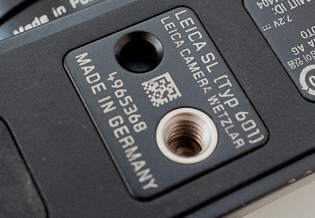 |
| |
|
|
The rubber ring on the battery
The Leica SL batteries have a rubber band that is for weather-sealing the camera in that department as well. The rubber ring feels loose when your finger moves over it, but is actually pretty well attached to the battery. |
|
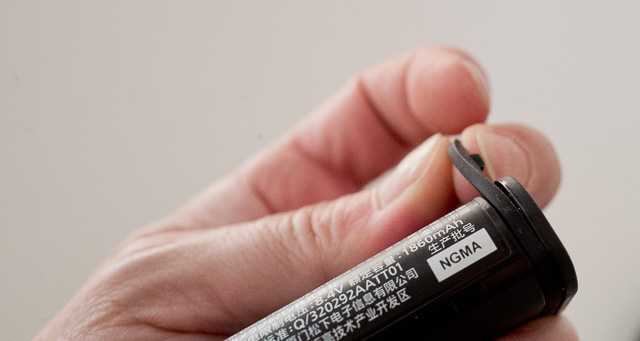 |
| |
|
|


Leica 180mm APO-Telyt-R f/3.4 on the Leica SL Type 601 via T to M adapter and M to R adapter.

Leica SL 601 Specifications:

Leica SL 601 Imaging Specifications:
| Lens Mount |
Leica L |
| Camera Format |
Full-Frame (1x Crop Factor) |
| Pixels |
Effective: 24 Megapixel |
| Maximum Resolution |
6000 x 4000 |
| Aspect Ratio |
3:2 |
| Sensor Type |
CMOS |
| Sensor Size |
24 x 36 mm |
| Image File Format |
DNG, JPEG |
| Bit Depth |
14-Bit |
| Image Stabilization |
None |

Leica SL Exposure Control Specifications:
| ISO Sensitivity |
Auto, 50 to 50000 |
| Shutter Speed |
Mechanical Shutter
1/8000 to 60 Seconds
Mechanical Shutter
0 to 30 Minutes in Time Mode
Bulb Mode |
| Metering Method |
Center-Weighted Average, Multi-Zone, Spot |
| Exposure Modes |
Aperture Priority, Manual, Program, Shutter Priority |
| Exposure Compensation |
-3 to +3 EV (1/3, 1/2 EV Steps) |
| White Balance |
Auto, Cloudy, Daylight, Flash, Fluorescent (Cool White), Fluorescent (Warm White), Manual, Shade, Tungsten |
| Continuous Shooting |
Up to 11 fps at 24 MP for up to 33 Frames (JPEG) |
| Interval Recording |
Yes |
| Self-Timer |
2/12-Second Delay |

Leica SL 601 Video Specifications:
| Recording Modes |
MOV
DCI 4K (4096 x 2160) at 24.00p
UHD 4K (3840 x 2160) at 24.00p/25p/29.97p
Full HD (1920 x 1080) at 24.00p/25p/29.97p/50p/59.94p/100p/119.88p
HD (1280 x 720) at 24.00p/25p/29.97p/50p/59.94p/100p/119.88p |
| External Recording Modes |
4:2:2 10-Bit
DCI 4K (4096 x 2160) |
| Recording Limit |
Up to 29 Minutes |
| Audio Recording |
Built-In Microphone (Stereo)
External Microphone Input |

Leica SL 601 Focus Specifications:
| Focus Type |
Auto and Manual Focus |
| Focus Mode |
Continuous-Servo AF (C), Manual Focus (M), Single-Servo AF (S), Touch AF & Shutter |
| Autofocus Points |
Contrast Detection: 49 |

Leica SL 601 Viewfinder and Monitor Specifications:
| Viewfinder Type |
Electronic |
| Viewfinder Size |
0.66" |
| Viewfinder Resolution |
4,400,000 Dot |
| Viewfinder Eye Point |
20 mm |
| Viewfinder Coverage |
100% |
| Viewfinder Magnification |
Approx. 0.8x |
| Diopter Adjustment |
-4 to +2 |
| Monitor Size |
2.95" |
| Monitor Resolution |
1,040,000 Dot |
| Monitor Type |
Fixed Touchscreen LED |

Leica SL 601 Flash Specifications:
| Built-In Flash |
No |
| Flash Modes |
Manual, TTL Auto |
| Maximum Sync Speed |
1/250 Second |
| Dedicated Flash System |
TTL |
| External Flash Connection |
Hot Shoe, PC Terminal |

Leica SL 601 Interface Specifications:
| Memory Card Slot |
Slot 1: SD/SDHC/SDXC (UHS-II)
Slot 2: SD/SDHC/SDXC (UHS-I) |
| Internal Memory |
None |
| Connectivity |
3.5mm Headphone, 3.5mm Microphone, HDMI A (Full Size), USB Micro-B (USB 3.0), PC Sync Socket |
| Wireless |
Wi-Fi |
| GPS |
Yes |

Leica SL 601 Environmental Specifications:
| Operating Temperature |
32 to 104°F / 0 to 40°C |
| Operating Humidity |
0 to 85% |

Leica SL 601 Physical Specifications:
| Battery |
1 x BP-SCL4 Rechargeable Lithium-Ion, 8.4 VDC, 1860 mAh |
| Dimensions (W x H x D) |
5.8 x 4.1 x 1.5" / 147 x 104 x 39 mm |
| Weight |
1.86 lb / 847 g (Body with Battery) |

Leica SL 601 Packaging Specifications:
| Package Weight |
5.53 lb |
| Box Dimensions (LxWxH) |
14.25 x 10.05 x 7.9" |

Reviews of the Leica SL Typ 601
Sean Reid Reviews: "Leica SL 601" (as of October 20, 2015).
Jono Slack: "Field Report (Three Weeks in Creta" (at GetDPI as of October 20, 2015).
Ming Thein: "The 2015 Leica SL (Typ 601) and lenses" (as of Oct 20, 2015).
Kristian Dowling: "Leica SL (Typ 601) Professional Mirrorless Camera Review" (as of Oct 20, 2015).
DPreview: "Hands-on with Leica SL (Typ 601)" (as of October 20, 2015).
CNET: "Review" (as of October 20, 2015)
PC Mag: "Leica SL" (as of October 20, 2015).
British Journal of Photography: "Full Specs" (as of Oct 20, 2015)
Nick Rains: Review (as of October 20, 2015).
PetaPixel: "Mirrorless War" (as of October 20, 2015).
Sean Reid Reviews: "Leica M and R on Leica SL" (as of October 20, 2015).
Steve Huff:
"My thoughts on the Leica SL" (as of October 20, 2015).
Jay Cassario: "Leica SL at weddings" (as of October 20, 2015).
Amateur Photographer: "Interview with Stephan Schulz on the Leica SL" (as of October 20, 2015).
Luminous Landscape: "What It Is and What It Isn’t" (as of October 22, 2015).
Husam Mneimneh: "The Real Competitor" (as of October 22, 2015)
Sean Reid "Some Thoughts on the new Leica SL" (as of October 22, 2015)
Erwin Puts: "The New Leica SL" (as of October 22, 2015)
Sean Reid: "35 mm rangefinder lenses on Leica SL and Leica M 240" (as of Oct 26, 2015)
DPReview: "Studio tests and samples: Leica SL (beta)" (as of October 28, 2015)
ClubSNAP: "Interview with Andreas Kaufmann and Oliver Kaltner" (as of October 28, 2015)
Sean Reid "Leica SL and Leica M 240 with Leica 35/1.4 Summilux-R and the Leitz Wetzlar 28/2.8 Elmarit-R" (as of November 16, 2015)
Steve Huff:
"Leica SL Hands On - Video and More" (as of November 17, 2015).
Kristian Dowling: "Leica SL (Typ 601) One Month User Experience" (as of November 22, 2015).
Erwin Puts: "First of three articles on the Leica SL Type 601" (as of November 26, 2015).
Jono Slack: "The Leica SL - A Field report"
Jono Slack: "Leica SL in Venice"
Erwin Puts: "The Leica SL, part 2" (as of December 2015 on ISO speed and dynamic range)
Joeri van der Kloet: "The Leica SL review" (as of December 19, 2015)
grEGORY simpson - Ultrasomething: "Camera Season - The Leica SL" (as of January 1, 2016)
BH Photo:
"Mirrorless Unleashed" (With comments on the Leica SL video features, as of January 2016)
DXOMARK: "Best-performing Leica to date" (as of January 21, 2016).
Kristen Meister: "Leica SL in the Cold" (as of January 26, 2016)
David Farkas: "A Professional Mirrorless Camera" (as of January 28, 2016).
Bigheadtaco: "Leica SL - Love of Hat or both?" (as of February 10, 2016)
Neil Buchan-Grant: "Location Portraiture with the Leica SL" (as of February 1, 2016)
Morten Albek: "The Leica SL Video Experience" (as of February 11, 2016)
Kirsten Meister: "The Leica SL: Six Month Field Test" (as of June 20, 2016)
Douglas Herr: "Leica SL vs. Sony a7II for Wildlife Photography" (as of June 26, 2016)
Leica SL lens reviews:
PC Magazine Review: "Leica Vario-Elmarit-SL 24-90mm f/2.8-4 ASPH" (as of November 2, 2015).
Kristen Meister: "Leica 90-280mm APO-Vario-Elmarit-SL f/2.8-4.0" (as of March 19, 2016).
David Farkas "Leica APO-Vario-Elmarit-SL 90-280mm f/2.8-4 lens review" (as of April 6, 2016).
Homework reading:
Leica SL Typ 601 Manual [English Only PDF - Cleaned out for the German part]
Leica SL Typ 601 Brochure [English PDF]
Leica SL Technical Specifications [English PDF]
Leica SL forum news:
L-Camera-User-Forum: Leica SL
To be continued ...
Sign up for the newsletter to get the next updates:
|
![]()
